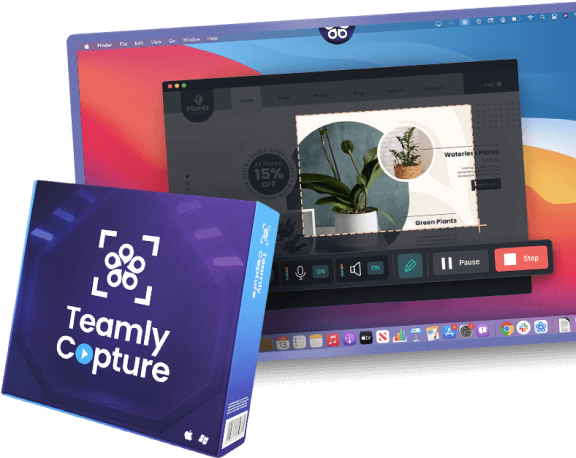
Click the button to start reading
In Search of Greener Pastures: The Best Alternatives to Hootsuite. Plus Three Social Media Hacks from Your Favorite Experts You Can’t Afford to Miss!
Social media places every organization in a never-ending performance on a global stage. There’s always multitudes of people browsing your announcements as they scroll feeds on Facebook, Instagram and Twitter. And when you least expect it, a customer calls you out in a busy public forum, either to celebrate or criticize you.
Under this spotlight of constant scrutiny, you can appear in the know, like an organization who’s engaged and contributing to the current conversation. Or you can look clueless and irrelevant, like someone who’s never up on the latest buzz and trends.
It’s not easy to consistently make a smart showing in this arena. In the complex, fast-paced world of social media, it’s nearly impossible to keep up on trending conversations across several platforms and to monitor and track individual campaigns to understand what’s working and what isn’t.
There’s definitely no way to do all of this manually. It gets down to having the right tool, a software that distills relevant trends, simplifies processes and brings your attention to what really matters.
Hootsuite, for sure, allows you to stay abreast and keep your head in the game. But by no means is it the only show in town. There’s several strong alternatives out there, each taking a slightly different approach to social media management and positioning itself at a competitive price point.
So if you’re burned out and frustrated with your current social media management system, I’ll let you in on a little secret: there’s a lot of options out there, and amongst them is a superior, bespoke solution that’s going to offer just what you’re looking for.
Let’s take a look at some of the key alternatives to Hootsuite and at how each of them stands out from the crowd.

What to Look For: The Deciding Factors of an SMM Tool
The right social media management tool serves several functions. It keeps you from having to switch between platforms, it allows all the necessary people to view content and it analyzes your impact with meaningful statistics.
Each system is a bit different, and is suited for different clientele. Some are built for marketing agencies with hundreds of accounts, while others are better for small businesses with only a few users and accounts. Each integrates with a different assortment of softwares and social media platforms.
When looking for the right tool for you, there’s a few key areas to hone in on. Let’s go over some of them.
Which Social Media Platforms and Other Softwares Does It Integrate With?
This is central. The social media management tool needs to integrate with the platforms you live on. If it doesn’t, then you’ll have to manually post content on these platforms.
Every tool integrates with the big four platforms: Twitter, Instagram, YouTube and Facebook. Beyond this, each offers a different assortment. If your organization uses Snapchat, TikTok, Pinterest or a niche emerging platform, this rules out several options and hones in on the solution that’s right for you. Social media content agencies develop innovative platform-specific content while managing post scheduling, engagement and performance tracking.
Similarly, each tool integrates with an assortment of other softwares, including communication platforms, photo editing tools and storage drives. Finding something that integrates with the softwares you’re using in your business makes things like sharing posts and analytics so much easier.
What Is Its Capacity?
A small company where one person managers five social media accounts is in a completely different pool than an agency overlooking 100 accounts.
Each social media management tool sets a limit on the number of users and social media accounts within each plan. There’s no need to go above and beyond your means, and you need to have enough capacity for your requirements as well.
Does It Provide Onboarding & Customer Support?
Onboarding and customer support are critical, particularly for a company that’s using a social media management tool for the first time.
Generally, the service a company offers increases with each of its plans. Lower tiers may only offer email support or no support at all, while premium or enterprise tiers have access to chat and telephone support.
How Is the User Experience and the Interface?
The usability of the platform can make all the difference. The viewing options for the calendar and each social media account determines how you’ll interact with the tool. Most companies provide demos and videos to demonstrate how its platform operates.
What About Tracking and Analytics?
Tracking and analytics allow you to understand how your content performs on various platforms, when the best times are to engage and what content sparks the greatest engagement.
Each tool offers a robust tracking and analytics system, with a variety of different features. Some break metrics down by country or region, while others let you create charts to download and share with clients.
Is It Worth the Money?
The cost for social media management tools varies wildly, from $60 a month to over $700 a month. And it’s not necessarily a scenario of getting what you pay for. Many believe that Hootsuite’s price is bloated, as other companies provide the whole package at a much lower price point.
Note that some companies boast of a certain feature or service, but it’s only available with the higher tier plans.
These six points address the key areas to survey when shopping for a social media management software. Now let’s look into some alternatives to Hootsuite per this criteria.
Who’s the Fairest: The Six Best Alternatives to Hootsuite
Each SMM management company offers its own competitive advantage, and serves a specific niche or clientele. Let’s evaluate several according to the attributes outlined above.
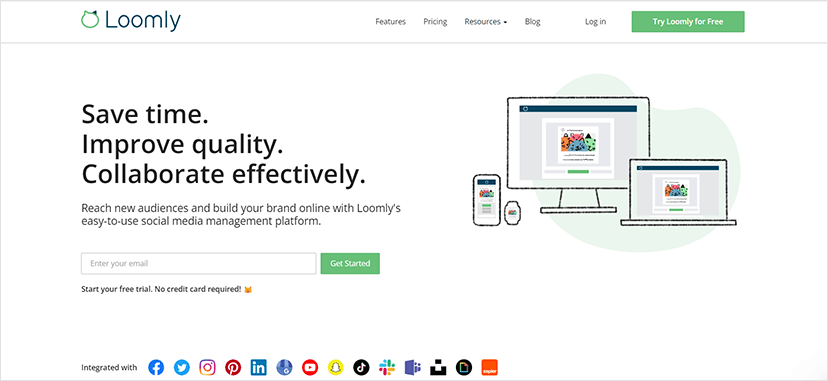
1. Loomly
Loomly is a social media management tool based out of Los Angeles. Just as a loom weaves wool to create textiles, Loomly aims to weave all the social media networks into a tapestry that achieves your marketing objectives.
Loomly began in 2015 by a frustrated French husband and wife team, Noemie and Thibaud Clement. They became flustered with managing a digital marketing agency with an Excel sheet and needed to level up.
Overview & Key Features
Loomly offers an intuitive, easy-to-use interface. Its dashboard provides a clear overview of its tools, which allows you to easily navigate to the right places. The calendar offers multiple viewing options, including the list view, which displays individual posts, and the calendar view, which displays the entire month in overview.
Many companies struggle to put out a continual stream of content, and Loomly assists with this challenge by offering content suggestions around themes such as holidays, throwback Thursday, Twitter trends and RSS feeds.
Customer Feedback & Limitations
Customers like how Loomly allows you to create content for specific audiences. However, some have cited that the mobile app glitches from time to time. They also say it’s a struggle to integrate all of the features of Instagram, such as stories. (This is a common complaint across all SMM services, however).
Social Media Integrations
Loomly integrates with many social media channels, including Facebook, Twitter, Facebook Ads, Instagram, Pinterst, Linkedin, Google My Business, YouTube, Snapchat and TikTok.
It also allows its users to integrate with a custom channel not natively integrated into Loomly. This includes smaller or niche platforms such as Tumblr, Gab or WordPress.
Other Software Integrations
In addition to social media platforms, Loomly also integrates with Unsplash, Giphy and Zapier. Advanced and premium tiers can integrate with Slack and Microsoft Teams.
Price & Free Options
Loomly offers a 15 day free trial.
Its pricing options encompass three tiers, ranging from $25 a month to $359 a month. It offers annual subscriptions for a discounted price. It also offers an enterprise option for custom services. The price for this package varies.
Capacity
The capacity varies depending on the plan. The package at the lowest tier includes two users and 10 social media accounts, while the highest tier includes 30 users and 50 social media accounts. The Enterprise option offers custom amounts.
Customer Support
Loomly offers chat and email support with all accounts. Enterprise accounts have a designated account manager.
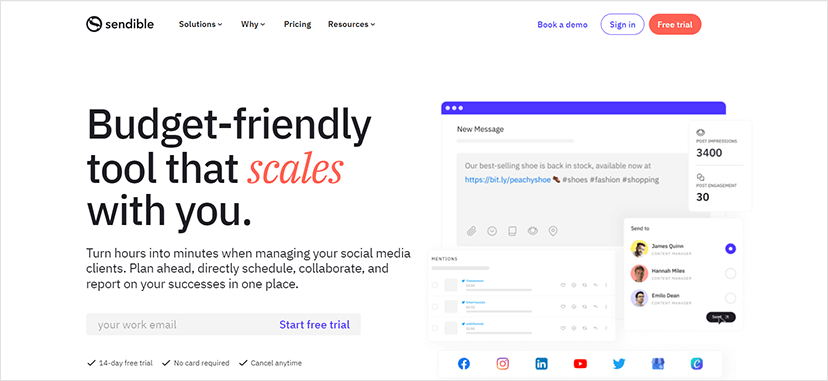
2. Sendible
Sendible boasts that with its platform, it takes less than an hour to schedule an entire months’ content!
This company started in 2009, inside the spare bedroom of Londoner Gavin Hammar, and evolved to keep pace with the ever-changing social media landscape. Currently it employees around 100 people, and operates mostly out of the UK.
Overview & Key Features
Sendible allows its users to manage up to 100 accounts and to post with multiple clients, making it a go-to for a digital marketing company.
With its “Scale” plan (the highest tier), users can build analytics reports and save them in pdfs to share with stakeholders and clients. It’s also possible to save content with the Scale plan.
User Experience
Users say it’s easy to collaborate with other team members on Sendible. They also find some of its features superior to Hootsuite. For example, its tracking tool provides metrics on hashtag views, which makes it easy to identify effective hashtags in posts. It’s also possible to schedule posts down to the minute, whereas Hootsuite only schedules within five minute intervals.
Social Media Integrations
Sendible integrates with Instagram, Facebook, Twitter, Linkedin, Google My Business and YouTube. Unlike many other tools, it also integrates with WordPress and WordPress.com, allowing users to manage a blog from the platform as well.
Other Software Integrations
Sendible integrates with Canva, Giphy, Pixels and Google Analytics. With the Scale plan, users can integrate with Google Drive and Dropbox.
Price & Free Options
Sendible offers a 14 day free trial.
Its plans range from the “Creator” plan ($29 a month), to the “Traction” plan ($89 a month), to the Scale Plan ($199 a month). Users can save 15% with a yearly subscription. It also offers a custom plan for larger teams.
Capacity
The Creator plan includes 1 user, 6 social profiles and 100 daily postings. The Traction plan includes 4 users, 24 social profiles and 200 daily postings and the Scale plan 7 users, 49 social profiles and 300 daily postings.
Customer Support
All plans provide email support, live chat and group training sessions. The Scale plan includes a dedicated customer service manager.
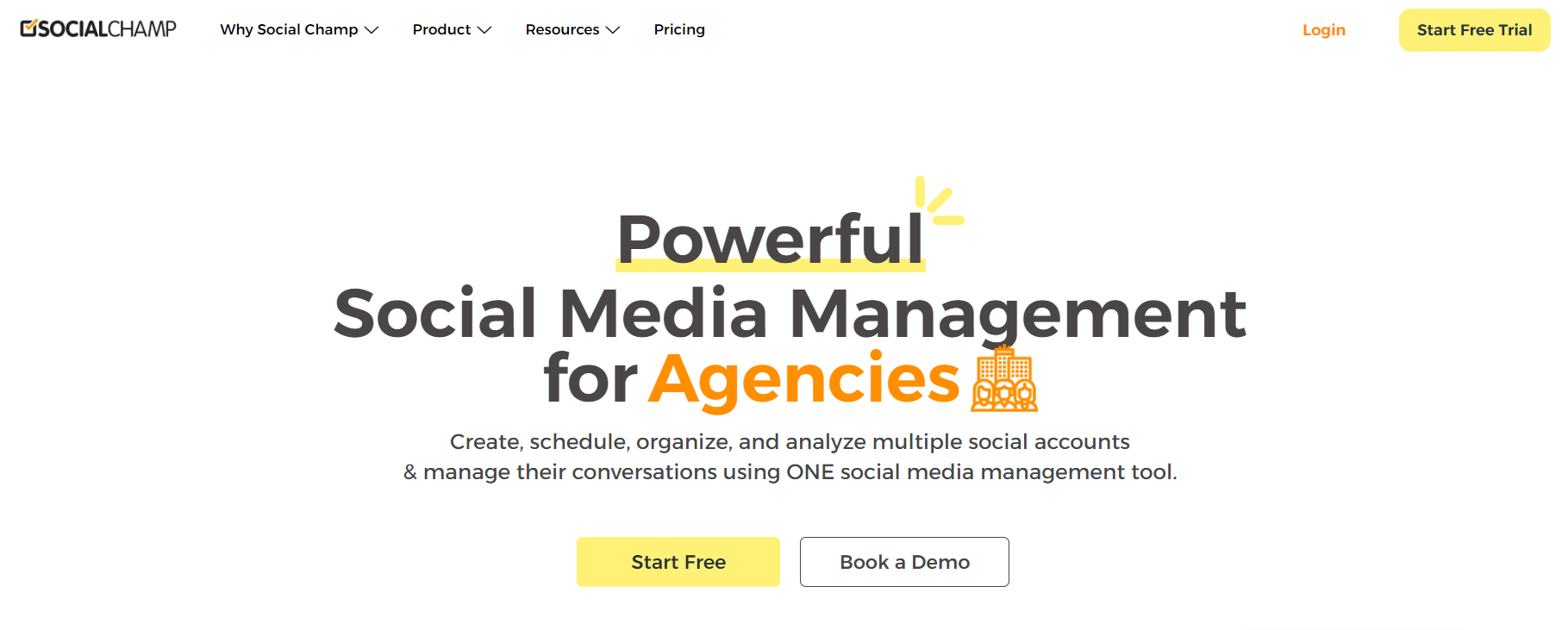
3. Social Champ
Social Champ is a social media management tool that empowers businesses to effortlessly schedule posts, collaborate with colleagues, and gain valuable insights into their audience engagement. It comes with a user-friendly interface, allowing users to schedule posts for optimal timing, collaborate with team members without credential sharing, and leverage bulk upload features for maximum efficiency.
Overview & Key Features
Social Champ is considered an all-in-one tool, offering multi-platform support. With features like content creation and scheduling, team collaboration, advanced analytics, repeat and recycle options, and integration with visual content creation tools.
Additionally, Social Champ also extends advanced social media functions, such as auto RSS feeds, repeat and bulk uploads, an AI Suite for content and image creation, a centralized dashboard, and more.
Social Media Integrations
It allows integration with all major social media platforms, including Facebook, Instagram, Twitter, YouTube, Pinterest, LinkedIn, TikTok, Mastodon, and Google My Business.
Other Integrations
It further integrates with other third-party tools like Canva, Crello, OneDrive, WordPress, and Wave.video, among others, for seamless visual content creation within the platform.
Price & Free Options
Social Champ offers four pricing plans: Free, Champion (priced at $26/mo), Business (priced at $89/mo), and Agency plan with custom pricing.
Capacity
Social Champ’s Free plan can connect with 3 social accounts, but can only be managed by one user. The Champion plan allows users to connect up to 12 social accounts and collaborate with 2 team members. The Business plan can accommodate 40 social accounts and collaborate with up to 6 team members. With the Agency plan, businesses can connect 100+ accounts and collaborate with 10+ team members.
Customer Support
Social Champ offers customer support via live chat. It also offers customer care via emails, and customers also schedule a demo call.
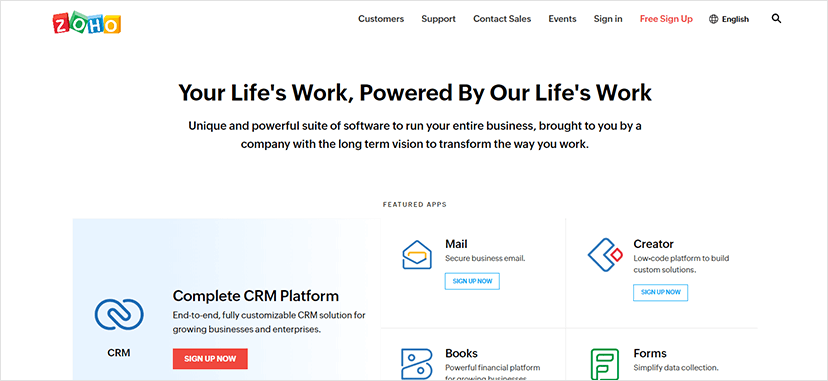
4. Zoho Social
Zoho is an Indian multinational technology company. It started in the 90s and currently has over 50 million users. Its name is a play on the phrase “small office, home office.”
In addition to SMM tools, Zoho offers an office suite, a cloud-based documents software, a platform for online meetings, mail services, human resource management tools and accounting services. It is headquartered in India with offices in China, Singapore, Africa, Japan and the United States.
Overview & Key Features
Zoho’s SMM tool offers “the whole package” at an awesome price. It offers collaboration tools, calendars and tracing analytics that call out issue tweets right away. Plus, it’s possible to package Zoho Social with the company’s many other services.
Limitations
Customers wish that Zoho Social integrated with more third party softwares. Some find that the mobile app is not as capable as the desktop version.
Social Media Integrations
Zoho integrates with Instagram, Facebook, Linkedin, Twitter, Google My Business, TikTok, YouTube and Pinterest.
Other Software Integrations
Some other third party softwares that Zoho links to include Canva, Zoho Desk (a project management platform), Linkedin Ads and Facebook Ads.
Price & Free Options
Zoho offers a 15 day free trial.
Its plans range from $10 a month for the standard plan to $40 a month for the premium plan, making it the cheapest tool out there by far. For agencies with 100 to 200 channels, it offers plans that range from $230 to $330 annually.
Capacity
The standard plan offers nine channels and one team member, while the premium offers ten channels and three team members. Additional brands and team members can be added for additional fees.
Customer Support
Zoho offers email support 24 hours a day, 5 days a week for all of its plans.
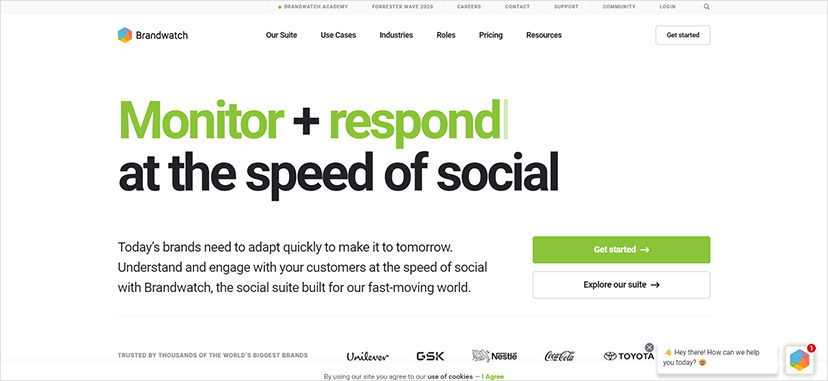
5. Brandwatch (formerly Falcon.io)
Founded in 2007 by Giles Palmer of the UK, Brandwatch currently runs 15 offices in cities across the world, including New York, London, Paris, Singapore and Sydney. Its SMM services are modeled after Falcon.io, which it acquired just a few years ago.
Overview & Key Features
Brandwatch is geared for larger businesses, and its service offers eight products: Publish, Influence, Advertise, Engage, Measure, Audience, Benchmark and Listen. These products collectively offer custom plans that allow teams to develop highly detailed and profitable social media marketing campaigns.
User Experience
Users find that Brandwatch is pricey compared to other SMM services, but they like the platform’s smooth interface.
Social Media Integrations
Brandwatch links with Facebook, Instagram, Twitter, TikTok, YouTube and Linkedin.
Price & Free Options
Brandwatch offers a 14 day free trial.
Its plans start at $108 a month. The company consults with potential clients individually and offers a custom price and services package.
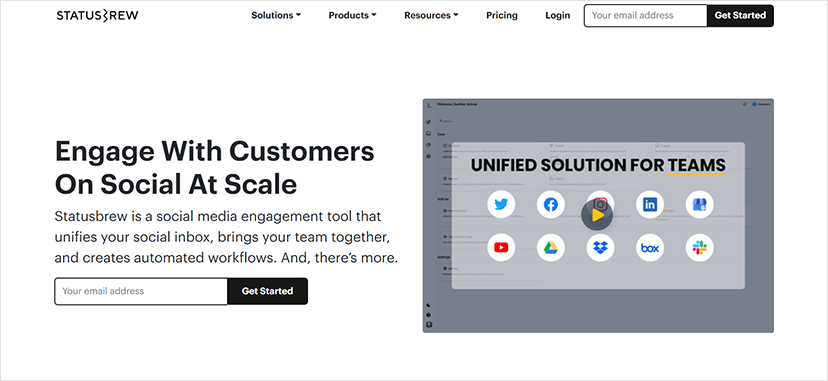
6. Statusbrew
Statusbrew has a clean interface and offers the expected range of SMM management tools. This includes stock photos for content and the capacity to modify posts for different platforms and shorten links within posts. Each post can be sent to a team member for approval. Its analytics breaks content down by country.
Social Media Integrations
Statusbrew integrates with Twitter, Instagram, Linkedin, Facebook, YouTube and Google My Business.
Other Software Integrations
Statusbrew also integrates with a host of other communication and storage softwares, including Slack, Bitly, Shopify, Zendes, Google Drive, Dropbox, One Drive, Hubspot, Salesforce, Mailchimp and Zapier.
Price & Free Options
The first seven days of Statusbrew are free.
It offers three plans, ranging from $69 to $229 a month.
Capacity
Its basic plan allows 5 users with 5 social profiles, and its premium plan 8 users and fifteen social profiles. The enterprise plan offers custom features, users and social profiles.
Customer Support
The customer support Statusbrew offers increases with each tier of the packages it offers. It offers email support with its basic plan and both email and chat support with its second and third-tier plan. Phone support is only available with the enterprise account.
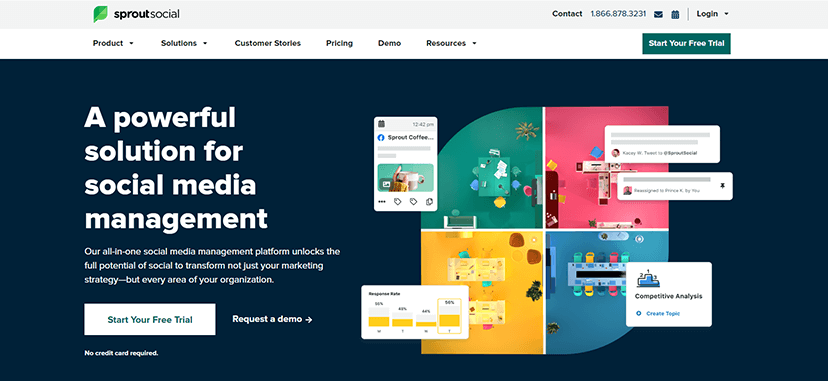
7. Sprout Social
Sprout Social is a publicly traded company based out of Chicago that was founded in 2010 by Justin Howard, Aaron Rankin, Gil Lara and Peter Soung. Some noteworthy clients include Glassdoor and Shopify.
Overview & Benefits
Sprout social allows its users to create, deliver and measure content, both on a computer and a mobile app. The interface allows content to be assigned to specific people and to be submitted for approval before going live.
Sprout offers a listening tool, “Sprout Listening” that enables users to be in the know, in the flow. This tool integrates with Facebook, Twitter, Instagram, Reddit, YouTube, Rumble and the web at large. Its purpose is to identify relevant conversations, which allows its users to chime in and participate in topical conversations as they’re happening.
Customer Feedback
Customers find that Sprout Social offers excellent customer services and a thorough onboarding process. Some found that there were too many handoffs in the onboarding process, however. Many like it for its clean and easy-to-use interface, and its capacity to duplicate content for repeat posting.
Social Media Integrations
Sprout Social integrates with a lot of the familiar faces: Facebook, TikTok, Instagram, Linkedin, YouTube and Pinterest.
Other Software Integrations
Sprout Social offers integrations with many third party softwares, including Google My Business, Tripadvisor, Glassdoor, Facebook Shops, Zendesk, Reddit, Google Analytics, Slack, Dropbox, Google Drive, Bitly, Canva, Shopify and Feedly.
Price & Free Options
Sprout Social offers a 30 day free trial.
Its plans include three tiers, ranging from $249 to $499 a month. It also offers a custom enterprising option.
Capacity
Sprout Social offers 5 social profiles at the basic level, then unlimited profiles at the middle and highest tier. It only offers one user with each package. Each additional user costs another $200 to $350 a month, depending on the tier.
Customer Support
Sprout Social offers 24 hour five day support that is prioritized for the Enterprise Level.
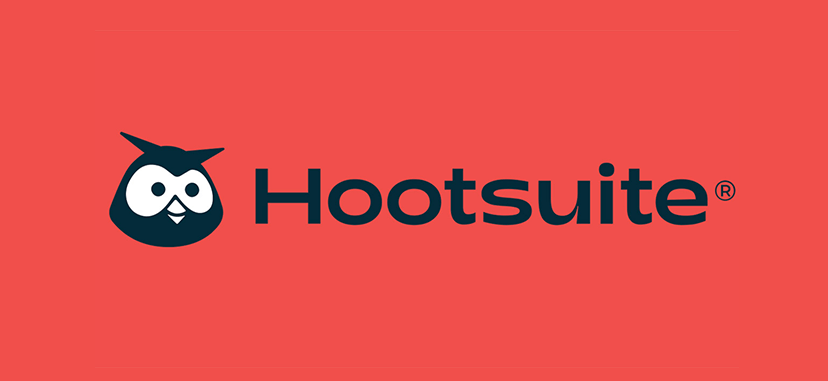
Hootsuite: How It Stacks Up
Now that we’ve looked at some of the key SMM management companies, you’re probably wondering how Hootsuite stacks up against them. Let’s get into it.
Hootsuite was started in 2008 by Ryan Holmes. The company is based out of Vancouver, British Columbia and also has offices in Sydney, Mexico City and Rome. Its unusual name emerged from a competition where Holmes crowdsourced suggestions. It comes from the French expression “tout de suite” that means “right now.”
Overview & Key Features
Hootsuite offers the same package as most other SMM management companies: boards to break social media feeds down by various criteria, a message box that gathers messages from all platforms and a calendar with drag and drop features. It also offers robust analytics tools.
Limitations
At over $700 for its premium package, Hootsuite is priced well above its competition. It doesn’t offer customer support for its smaller packages. Some feel that Hootsuite aims to exclusively serve large companies with custom enterprise plans.
Social Media Integrations
Hootsuite integrates with many of the same key players: Instagram, Facebook, TikTok, Twitter, YouTube, Linkedin and Pinterest.
Other Software Integrations
It offers flexible integration options with other softwares, including Canva, Shopify, Hubspot, Zendesk, Google My Business and Dropbox.
Price & Free Options
The first month of Hootsuite is free.
Its plans range from a professional plan that’s $99 a month to a business plan that’s $739 a month. It also offers custom enterprise solutions.
Capacity
The professional plan includes one user and 10 social accounts, and the business plan five users and 35 accounts. The enterprise options start at five users with 50 accounts.
Customer Support
Hootsuite only offers customer support at the Business Tier and Enterprise plan.
As you can see, Hootsuite has positioned itself as a key player in the SMM management milieu. It’s got all the features necessary to fluidly permeate your message across many channels.
However, it’s pricier than its competitors, and doesn’t offer any customer support for lower tier clients. Many other companies cost far less and offer services that Hootsuite does not. So it pays to do your homework and research the right plan for you.

What’s the Next Step? 3 SMM Strategies From Your Favorite Experts
Finding the perfect social media management tool is only half the battle.
Another component to a successful marketing strategy is knowing what to say and how to say it. To this end, here are a few simple pointers from the experts on content marketing.
Gary Vee: Customize Content for Each Platform
Pushing your message across multiple platforms is the ticket to reaching a wide audience. But a simple cut and paste job isn’t going to cut it, SMM expert Gary Vaynerchuk stresses in his most recent book, Crushing It.
Gary points out that each social media platform serves a different function. Twitter is the go-to for news and quick sound bytes, while Facebook is the place to connect with family and friends. And YouTube, often, is the place where people land when they have a few hours to chill on a Saturday afternoon.
In order to connect with our audience, then, the content needs to be adapted to suit each platform.
“Develop high-quality native micro content…This means content that is specifically and purposely designed to suit the platform you’re using to disseminate it. The audience on Twitter isn’t looking for the same kind of content as an Instagram follower. A Facebook post will have greater impact if it’s not just a cut and paste job from your blog or a ten minute video that should actually be living on YouTube.”
This doesn’t mean creating original content for each platform. One large piece of content, such as a blog post or a video, can be splintered and distributed among many platforms. However, the content needs to be molded and edited to suit the platform in order to reach your audience.
Marie Forleo: Consistency Is the Name of the Game
Marie Forleo is the author of the book Everything Is Figureoutable and creator of the popular online program, B-School. Although some believe she’s a bit of a charlaton running a pyramid scheme, she does provide some SMM lessons that are dead on.
One key lesson she drives home is the need for consistency in online marketing.
“Success doesn’t come from what you do occasionally, it comes from what you do consistently.”
Consistency is reflected in where you show up online, how you show up and when you show up. Content is easily recognizable when it uses similar colors, fonts and themes. When customers come to anticipate a weekly blog post or a daily Instagram post, it increases their familiarity with your message and your brand. This “like, know, trust” factor is key to winning devoted customers.
Amanda Slavin: Vanity Metrics versus Real Engagement
The goal of SMM, Amanda Slavin says in her book Seventh Level, is to turn your followers into brand ambassadors who don’t just follow and like your posts, but who market for you.
“Customers are no longer just the purchasers of your product, but people that can serve as an extension of your sales team. They “sell” for you when they advocate for you, follow you, connect with you, and are interested in what you have to say as a brand. Just think about what is more impactful: When you tell everyone how great you are? Or when your most loyal brand advocates rave about how wonderful you are to their friends, family and followers?”
To this end, stats need to be carefully evaluated to identify true engagement. When and how does engagement reflect a dedication to the brand, and when is it just a superficial ‘like’ or ‘follow’?
For example, an account with 10K followers who rarely interact may not have the impact as an account with 700 highly engaged followers who consistently comment, share content, and purchase from your organization.
Conclusion
It’s so common to pour energy into a social media campaign and have it fall flat. No engagement, no increase in sales, no nothing.
Oftentimes, this is because the effort wasn’t centralized.
Good SMM gets down to having the right tools that allow you to elevate and streamline efforts. It gets your finger on the pulse of the fast-paced organism that is social media.
There’s a lot of great SMM management companies out there in addition to Hootsuite, and so it’s worth the effort to research and find the right tool for you. What features do you look for in a social media management tool?



